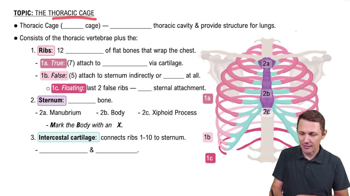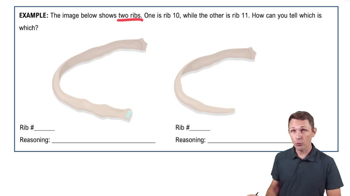The Thoracic Cage definitions Flashcards
 Back
BackThe Thoracic Cage definitions
1/13
Terms in this set (13)
- Thoracic CageA bony structure protecting the thoracic cavity, consisting of thoracic vertebrae, ribs, sternum, and intercostal cartilage.
- Thoracic CavityThe chest cavity housing vital organs like the lungs and heart, protected by the thoracic cage.
- Thoracic VertebraeTwelve vertebrae in the spine that articulate with the ribs, forming part of the thoracic cage.
- RibsTwelve pairs of flat bones forming the thoracic cage, providing protection and support.
- True RibsThe first seven pairs of ribs that attach directly to the sternum via their own costal cartilage.
- False RibsRibs 8 to 10 that attach to the sternum indirectly through cartilage connecting to other rib cartilage.
- Floating RibsThe last two pairs of ribs (11 and 12) that do not attach to the sternum.
- SternumA flat bone resembling a necktie, composed of the manubrium, body, and xiphoid process.
- ManubriumThe upper part of the sternum, resembling the knot of a necktie.
- BodyThe central part of the sternum, forming the long section of the necktie shape.
- Xiphoid ProcessThe small, cartilaginous tip of the sternum, serving as an attachment point.
- Intercostal CartilageFlexible cartilage connecting ribs 1 through 10 to the sternum, providing strength and flexibility.
- Costal CartilageCartilage that connects ribs to the sternum, allowing for flexibility and movement.


